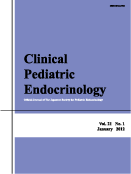巻号一覧

23 巻 (2014)
- 4 号 p. 99-
- 3 号 p. 65-
- 2 号 p. 27-
- 1 号 p. 1-
23 巻, 4 号
選択された号の論文の3件中1~3を表示しています
- |<
- <
- 1
- >
- >|
Review
-
Eiji Kawasaki2014 年 23 巻 4 号 p. 99-105
発行日: 2014年
公開日: 2014/11/06
ジャーナル オープンアクセスType 1 diabetes (T1D) is an organ-specific autoimmune disease caused by the autoimmune response against pancreatic β cells. T1D is often complicated with other autoimmune diseases, and anti-islet autoantibodies precede the clinical onset of disease. The most common coexisting organ-specific autoimmune disease in patients with T1D is autoimmune thyroid disease, and its frequency is estimated at > 90% among patients with T1D and autoimmune diseases. The prevalence of anti-thyroid antibodies in children with T1D at disease onset is about 20% and is particularly common in girls. Furthermore, patients with anti-thyroid antibodies are 18 times more likely to develop thyroid disease than patients without anti-thyroid antibodies. Therefore, for early detection of autoimmune thyroid disease in children with T1D, measurement of anti-thyroid antibodies and TSH at T1D onset and in yearly intervals after the age of 12 yr is recommended. Anti-islet autoantibodies are predictive and diagnostic markers for T1D. The most frequently detected autoantibodies in Japanese patients are GAD autoantibodies (~80%) followed by IA-2 autoantibodies (~60%), insulin autoantibodies (~55%) and ZnT8 autoantibodies (~50%). In a combined analysis, 94% of Japanese patients with T1D can be defined as having type 1A diabetes. Furthermore, autoantibodies to ZnT8 and IA-2 are associated with childhood-onset and acute-onset patients. Thus, it is important to develop a diagnostic strategy for patients with type 1A diabetes in consideration of the age or mode of disease onset.抄録全体を表示PDF形式でダウンロード (1241K)
Original Article
-
Toshiaki Tanaka, Yukihiro Hasegawa, Susumu Yokoya, Yoshikazu Nishi2014 年 23 巻 4 号 p. 107-114
発行日: 2014年
公開日: 2014/11/06
ジャーナル オープンアクセスWe investigated whether treatment with an intranasal GH-releasing peptide (GHRP)-2 spray, which acts as a potent GH secretagogue that stimulates endogenous GH secretion, promotes growth in patients with GH deficiency (GHD). This study involved 126 prepubertal short children (81 males, 45 females) with a height SD score of –2 SD or less, who had been diagnosed as having GHD based on GH stimulation tests, and in whom the serum GH concentrations increased up to 9 ng/ml after preliminary administration of an intranasal GHRP-2 spray. The subjects included in this study were divided into 3 groups by use of a double-blind method; that is 44 were placed into the placebo group (P group: 30 males, 14 females), 41 were placed into the GHRP-2 low dose group (L group: 25 males, 16 females), and 41 were placed into the GHRP-2 high dose group (H group: 26 males, 15 females). Those with a body wt of less than 20 kg were administered a placebo (P group), 50 μg of GHRP-2 (L group) or 100 μg of GHRP-2 (H group), and those with a body wt of 20 kg or more were administered a placebo (P group), 100 µg of GHRP-2 (L group) or 200 µg of GHRP-2 (H group) twice daily (morning and evening) for 48 continuous wk. Age and height SD scores at baseline were not significantly different among the three groups: 7.5 yr old and –2.26 SD in the P group, 7.3 yr old and –2.38 SD in the L group, and 7.5 yr old and –2.27 SD in the H group. Of the 126 subjects, 44, 40 and 40 subjects in the P, L and H groups, respectively, completed the 48 continuous wk of treatment. The changes in the mean height SD scores (mean growth rate) after 48 wk of treatment in the P, L and H groups were 0.07 SD, 0.03 SD, and 0.02 SD, respectively, and thus no significant differences was observed among the 3 groups. Also no significant changes in blood IGF-I levels at baseline or after 48 wk of treatment were observed among the 3 groups. This study revealed that in patients with GHD, an increase in endogenous GH secretion as a result of treatment with GHRP-2 does not promote growth. It is speculated that the area under the curve of serum GH concentration by GHRP-2 spray is too small to produce biological effects. In conclusion, it was demonstrated that growth cannot be promoted by a transient increase in endogenous GH secretion.抄録全体を表示PDF形式でダウンロード (616K)
Mutation-in-Brief
-
Takashi Daitsu, Junko Igaki, Masahiro Goto, Yukihiro Hasegawa2014 年 23 巻 4 号 p. 115-117
発行日: 2014年
公開日: 2014/11/06
ジャーナル オープンアクセスPDF形式でダウンロード (437K)
- |<
- <
- 1
- >
- >|